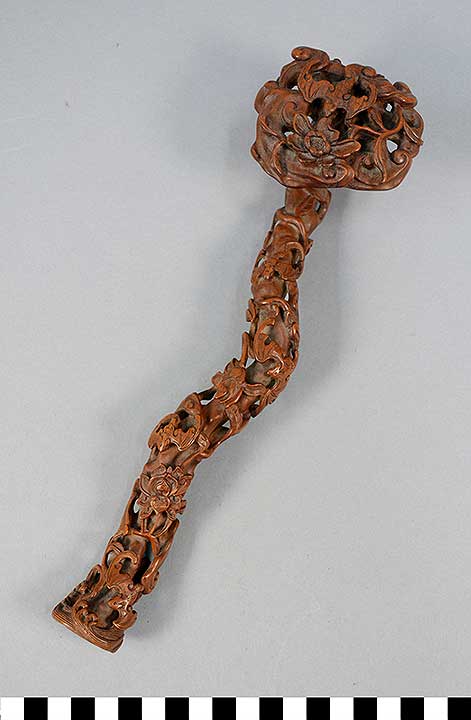Ruyi Scepter
2017.13.0003A
Detailed Images
Basic Information
| Artifact Identification | Ruyi Scepter (2017.13.0003A) |
|---|---|
| Classification/ Nomenclature |
|
| Artist/Maker | None |
| Geographic Location | |
| Period/Date | Qianlong Period, 1736-1796 CE |
| Culture | N/A |
Physical Analysis
| Dimension 1 (Height) | 26.9 cm |
|---|---|
| Dimension 2 (Width) | 5.84 cm |
| Dimension 3 (Diameter) | 3.13 cm |
| Weight | 87 g |
| Measuring Remarks | The width was measured from the largest end (i.e., the head of the scepter)and includes the empty space between the shaft and the head. |
| Materials | Plant--Boxwood, Varnish |
| Manufacturing Processes | Carved |
| Munsell Color Information | N/A |
Research Remarks
| Published Description | N/A |
|---|---|
| Description | An intricately and finely carved 18th century, Qianlong period (1736-1796), Chinese boxwood (huangyang mu) ruyi scepter, carved in high relief with openwork. The motifs are wufu (bats), fungi, and lotus. The ruyi, with a fitted silk base, measures 10.75 inches long. Ruyi (literal meaning: ‘as desired; as [you] wish’) is an object that serves as a ceremonial scepter in Chinese Buddhism or a talisman symbolizing power and good fortune in Chinese folklore. These scepters were traditionally presented as birthday gifts. Ruyi scepters are long, shaped in the stylized stalk of a lotus. The ruyi scepter is also the emblem/attribute of He Xiangu, one of the Eight Daoist immortals. The Yang (female principle) character of the Ruyi is often indicate by its similarity to the Lingzhi fungus and to Clouds. During the Qing dynasty, it was customary for the Emperor to present deserving generals, nobles and ministers of state with gifts of a Ruyi scepter as a mark of favor. |
| Comparanda | Lot 2908, A Boxwood “Bird and Flower’ Ruyi Qing Dynasty 18th century. Christie’s Hong Kong sale 3432: Through Connoisseur’s Eyes-Ephemeral Flowers, Enduring Art. June 3, 2015. lot 951, A Boxwood Ruyi scepter, 19th century. Christies’ New York sale 3769: The Lai Family Collection of Fine Chinese Furniture and Works of Art. September 17, 2015. |
| Bibliography | N/A |
Artifact History
| Archaeological Data | N/A |
|---|---|
| Credit Line/Dedication | Fred A. Freund Collection |
| Reproduction | N/A |
| Reproduction Information | N/A |
